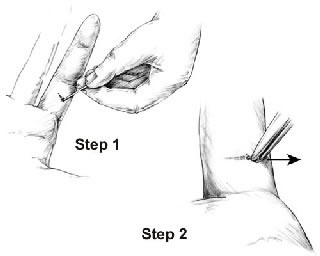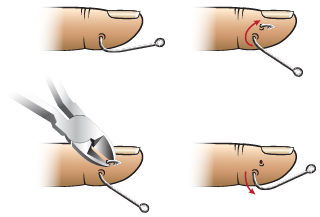Photos

FIRST AID Advice - How to Remove a Splinter
You can remove splinters, larger slivers, and thorns with a needle and tweezers. Check the tweezers before you start, to be certain the ends meet exactly. If they do not, bend them until they do. Sterilize the tools with rubbing alcohol or a flame.
Clean the skin around the sliver carefully with rubbing alcohol before trying to remove it. Be careful not to push the splinter in deeper. If you don't have rubbing alcohol, use soap and water, but don't soak the area if splinter is wood. Reason: soaking can cause swelling of the splinter.
Remove the splinter:
- Step 1: use the needle to completely expose the large end of the sliver. Use good lighting. A magnifying glass may help.
- Step 2: then grasp the end of the sliver firmly with the tweezers and pull it out at the same angle that it went in. Getting a good grip the first time is very important for slivers that go in perpendicular to the skin or those trapped under the fingernail.
Source: Self Care Decisions, LLC
Used with Permission from Schmitt Pediatric Guidelines LLC.

FIRST AID Advice - Removing a Fishhook from a Finger
This method of fishhook removal is sometimes called the Advance and Cut Method.
There are four steps in removing a fishhook:
- Step 1. Using pliers (or needle drivers) firmly grasp the hook.
- Step 2. Push (advance) the hook until the tip of the hook pops out through the skin.
- Step 3. Cut off the tip of the hook and the barb.
- Step 4. Back out the hook out.
Important Note:
- Use these instructions when you can't get into see a doctor right away. Most of the time, it is best to have a doctor (or other health care provider) remove a fishhook.
- The hook in this drawing has only a single barb at the tip, so the tip of the hook (with the barb) can be cut off and the hook pulled backwards through the skin.
- Some hooks can have more than one barb. In such cases, it is better to cut off the ring at the bottom of the hook and push the hook all of the way through the skin.
Source: Self Care Decisions, LLC
Used with Permission from Schmitt Pediatric Guidelines LLC.